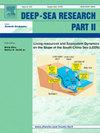Sedimentary phosphorus in the Persian Gulf and the Gulf of Oman: Geochemical fractionation, seasonal variations, potential bioavailability, and ecological risk
IF 3
3区 地球科学
Q2 OCEANOGRAPHY
Deep-sea Research Part Ii-topical Studies in Oceanography
Pub Date : 2025-07-28
DOI:10.1016/j.dsr2.2025.105524
引用次数: 0
Abstract
Phosphorus is a vital macronutrient that regulates marine biogeochemical cycles and ecosystem production. This is the first thorough investigation of phosphorus geochemistry in surface sediments of the Persian Gulf (PG) and the Gulf of Oman (GO), quantifying its fractions, potential ecological risks and potential bioavailability. Five forms of phosphorus were quantified using a sequential extraction technique. TP ranged from 636.0 to 1341.3 μg/g and 599.6–1354.1 μg/g in the summer and winter, respectively. Calcium-bound phosphorus (Ca-P) and detrital phosphorus (De-P) were the dominant forms of TP in surface sediments, with following descending order to other forms: O-P > Fe-P > Ad-P. Inorganic phosphorus (P) comprised over 83 % of the TP in the study area's sediments, indicating a low contribution from organic phosphorus. A mean of 29.1 % and 25.3 % of TP was found to be bioavailable phosphorus during the summer and winter sampling periods, respectively. Phosphorus pollution index exceeded one at most stations in both seasons, indicating sediment phosphorus pollution. Effective management of phosphorus inputs and maintenance of phosphorus balance are recommended to prevent eutrophication and HABs in the PG and GO.
波斯湾和阿曼湾的沉积磷:地球化学分馏、季节变化、潜在的生物利用度和生态风险
磷是调节海洋生物地球化学循环和生态系统生产的重要常量营养素。这是第一次对波斯湾(PG)和阿曼湾(GO)表层沉积物中磷的地球化学进行全面调查,量化了其组分、潜在的生态风险和潜在的生物利用度。采用顺序萃取技术对磷的五种形态进行了定量分析。夏季TP值为636.0 ~ 1341.3 μg,冬季TP值为599.6 ~ 1354.1 μg。表层沉积物中磷的主要形态为钙结合磷(Ca-P)和碎屑磷(De-P),其他形态依次为:O-P >;磷比;Ad-P。研究区沉积物中无机磷(P)占总磷的83%以上,表明有机磷的贡献较低。在夏季和冬季取样期间,TP中平均29.1%和25.3%为生物可利用磷。两个季节大部分站点的磷污染指数均超过1,表明沉积物磷污染。建议有效管理磷输入和维持磷平衡,以防止PG和GO的富营养化和赤潮。
本文章由计算机程序翻译,如有差异,请以英文原文为准。
求助全文
约1分钟内获得全文
求助全文
来源期刊
CiteScore
6.40
自引率
16.70%
发文量
115
审稿时长
3 months
期刊介绍:
Deep-Sea Research Part II: Topical Studies in Oceanography publishes topical issues from the many international and interdisciplinary projects which are undertaken in oceanography. Besides these special issues from projects, the journal publishes collections of papers presented at conferences. The special issues regularly have electronic annexes of non-text material (numerical data, images, images, video, etc.) which are published with the special issues in ScienceDirect. Deep-Sea Research Part II was split off as a separate journal devoted to topical issues in 1993. Its companion journal Deep-Sea Research Part I: Oceanographic Research Papers, publishes the regular research papers in this area.

 求助内容:
求助内容: 应助结果提醒方式:
应助结果提醒方式:


